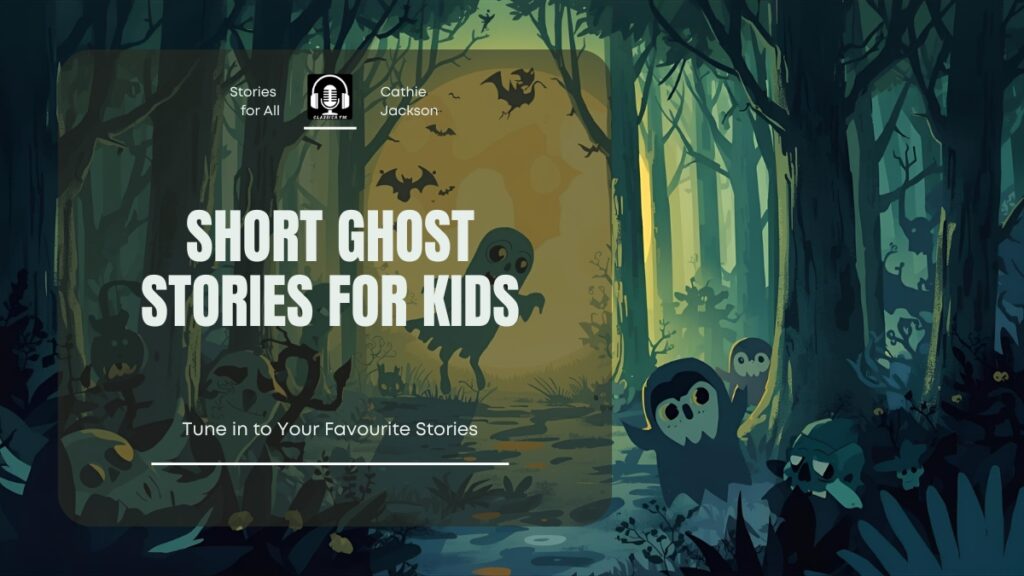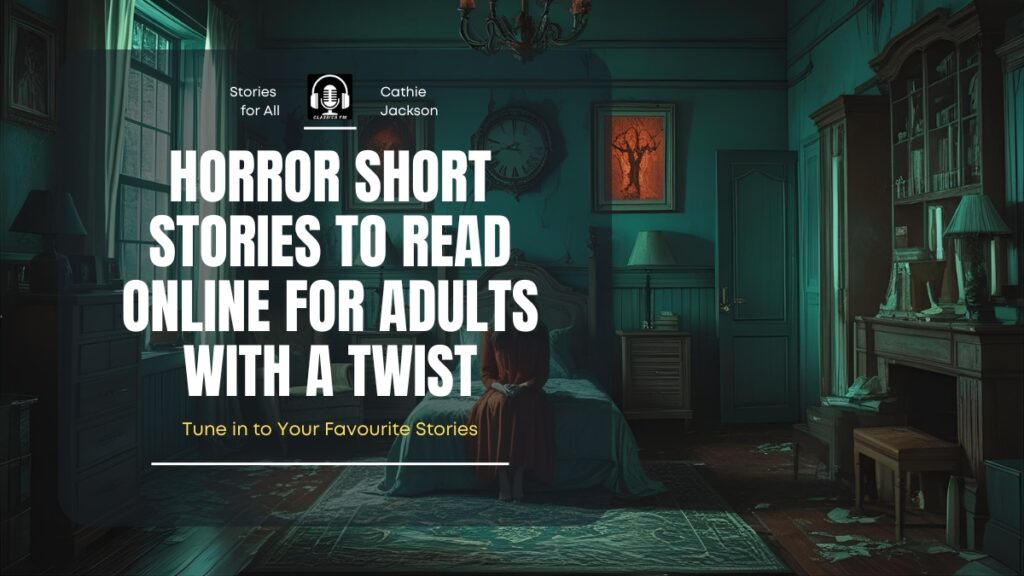If you’re searching for short ghost stories for kids that are spooky but safe, you’ve come to the right place.
This guide answers the question directly: how to choose, tell, and enjoy short ghost stories for kids while protecting little listeners from night-time anxiety.
You’ll get ready-to-use stories, age recommendations, safety guidelines, and tips to make spooky reading a positive experience.
Why parents and teachers choose short ghost stories for kids
Short ghost stories for kids offer a controlled way to explore fear, curiosity, and imagination. Read aloud sessions boost vocabulary, comprehension, and emotional skills.
Major pediatric and literacy organizations encourage shared reading as a way to build language, bonding, and social-emotional learning.
The American Academy of Pediatrics recommends shared reading from infancy because it supports language and nurturing relationships.
Reading specialists also note that reading aloud helps children practice emotion regulation and empathy — important when stories include safe, spooky emotions.
Short Ghost Stories for Kids
From friendly phantoms to glowing lanterns, every story in this collection brings a soft chill and a big smile. Perfect for curious kids and cozy nights!
1. The Whispering Library
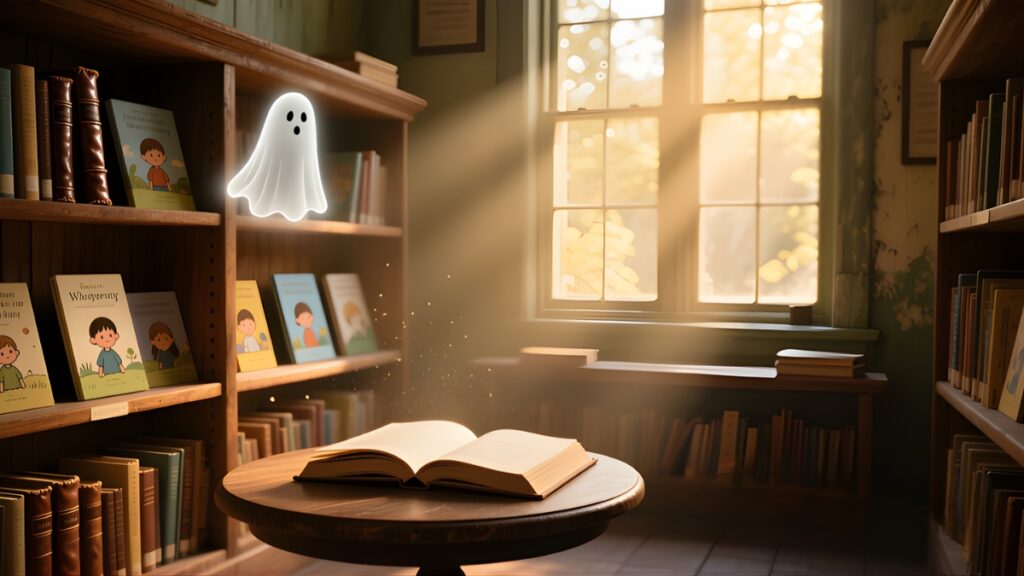
Mia loved her school library more than any place in the world. It smelled of paper, dust, and something else—something old and mysterious.
Every Friday after class, while the others rushed to the playground, Mia stayed behind to help Mrs. Elkin, the librarian, tidy up the reading corner.
One chilly afternoon, when the sun dipped behind gray clouds and the wind scratched softly against the windows, Mia noticed something strange.
A faint whisper.
It wasn’t Mrs. Elkin. The librarian was busy stamping return dates and humming an old tune. The sound came from the far end of the room—from the shelf no one ever touched.
That shelf had a crooked sign that read “Local Legends and Lost Tales.”
Mia had walked past it a hundred times, but today, the whispering pulled her closer.
She stood still, listening.
It sounded like paper sighing… or maybe a voice hidden between pages.
“Mrs. Elkin?” Mia asked. “Do you hear that?”
The librarian looked up from her desk. “Hear what, dear?”
“The whispering,” Mia said.
Mrs. Elkin smiled kindly. “Ah, the library has a voice of its own when it’s quiet enough. Books like to be noticed.”
Mia tried to laugh, but her heart beat faster. She turned back toward the shelf. One of the books—thin, blue, and glittering faintly—was sticking out farther than the others.
The title was The Town That Disappeared.
The Book That Moved
Mia reached for it, but before she touched the spine, the whisper came again, clearer this time.
“Find the forgotten story…”
She froze.
Her fingers trembled, but curiosity won. She pulled the book from the shelf. A cloud of dust rose into the air, swirling like smoke.
The library lights flickered.
Inside, the pages were blank.
All of them.
Mia frowned. “That’s weird,” she whispered.
Then—right before her eyes—letters began to appear, curling across the page in glowing ink.
“The town vanished one night. Only the library remained.”
Mia gasped. “Mrs. Elkin!” she called, but no one answered. The library was suddenly silent. Too silent.
She turned around. Mrs. Elkin was gone.
So were the windows.
The library stretched endlessly, shelf after shelf vanishing into shadow.
The Whisper Returns
The voice spoke again, soft but urgent.
“Every story needs to be remembered. Will you help us, Mia?”
Mia’s voice shook. “Help who?”
“The stories that were forgotten.”
A faint shape appeared—a little girl about Mia’s age, dressed in old-fashioned clothes. She looked faded, like a drawing half-erased.
“I used to read here,” the girl said. “Our whole town did. But when people stopped telling our stories, the town disappeared. Only the books remain.”
Mia stepped closer. “You’re a ghost?”
The girl smiled sadly. “A story ghost.”
Mia didn’t know what to say. She looked at the blank pages still glowing faintly. “Can I bring it back?”
“Yes,” said the ghost. “But you must finish our story.”
The Story That Saved a Town
Mia sat on the floor, the ghost beside her. The library around them seemed to hold its breath.
She took a pencil from her backpack. “Okay,” she said. “Let’s begin.”
The ghost started to whisper—names, places, laughter that once filled streets. As she spoke, Mia wrote everything down.
A bakery that smelled of sugar.
A clock tower that rang only at sunset.
A bridge where children dropped pebbles for luck.
As Mia wrote, color returned to the ghost’s face. The ink glowed brighter. Shelves creaked like old wood waking from a long sleep.
Finally, the ghost whispered, “And the girl who remembered us was the hero of the story.”
Mia smiled and wrote that too.
The moment she finished the last word, a warm wind rushed through the aisles. The whispering became joyful, like dozens of voices laughing.
Then—everything went dark.
Back to the Real Library
When Mia opened her eyes, she was back at the familiar table. Mrs. Elkin was there, stamping a book.
“Mia?” she said. “You dozed off while reading. I was about to wake you.”
Mia blinked. The blue book lay open in her lap. Only this time, the pages weren’t blank.
They were filled with a story—a story she had written.
At the very end, in tiny letters, was a note:
Thank you for remembering us.
Mia smiled. She placed the book carefully back on the shelf under “Local Legends and Lost Tales.”
That Night
At home, as she brushed her teeth, Mia thought she heard something faint—like a whisper carried through the wind outside.
She leaned closer to the window.
“Good night, Mia,” the voice said.
She whispered back, “Good night, story ghost.”
And for a second, she thought she saw the faintest blue light glowing in the clouds—like pages turning in the sky.
Teacher/Parent Notes
Theme: Curiosity, courage, and the magic of remembering stories.
Moral: Every story deserves to be remembered. When we listen to the past, we keep its spirit alive.
Perfect for: Nighttime reading, creative writing inspiration, or classroom discussions about imagination and history.
2. The Ghost Who Forgot to Be Scary
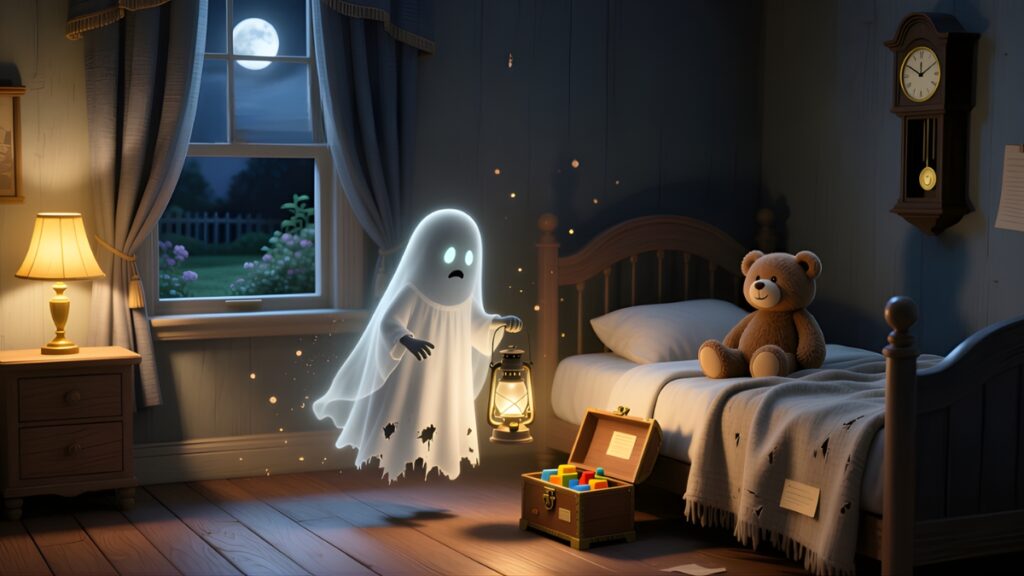
At the edge of Maple Hollow stood a small, creaky house that everyone called Wobbly Manor.
It wasn’t truly haunted—or at least, no one had ever proven it. But every Halloween, kids dared each other to walk past its rusted gate and whisper a greeting to the ghost said to live inside.
That ghost was named Percy.
And Percy had a problem.
He had completely forgotten how to be scary.
A Not-So-Spooky Ghost
Every night, when the moon shone through the cracked roof, Percy practiced his ghostly routine.
He’d float through the halls, rattle chains, and moan, “Oooooo!”
But his moans always came out as hiccups.
“Hoooo… hic… hooooo!”
His chains tangled around him like necklaces.
And whenever he tried to swoop dramatically through a wall, he usually got stuck halfway and had to wiggle out with an embarrassed laugh.
Other ghosts from nearby towns had stopped by Wobbly Manor over the years. They would shake their heads sadly.
“Percy,” one said, “you’re supposed to terrify people!”
Another added, “You’re the friendliest ghost I’ve ever seen. It’s unnatural!”
Percy sighed. “Maybe I’m just not cut out for haunting.”
The Halloween Challenge
One October afternoon, Percy overheard voices outside the house. He peeked through a dusty window.
Three kids were standing at the gate: Max, Tasha, and Lily. Each held a flashlight.
Max grinned. “This is it! Whoever goes inside and grabs something from the haunted living room wins the dare.”
Tasha looked nervous. “But what about the ghost?”
Lily shrugged. “They say he’s the nicest ghost ever. I mean, how scary can that be?”
Percy’s eyes widened. Nicest ghost ever?
He puffed up his chest—well, the ghostly version of one. “Not anymore,” he said to himself. “Tonight, I’ll prove I can be scary!”
Operation: Be Terrifying
Percy rushed to prepare.
He draped himself in cobwebs, polished his old brass bell, and practiced his “Oooooo” in front of a cracked mirror.
He even wrote down a list titled “Top Ten Scary Things to Do.”
- Appear suddenly behind people.
- Make spooky noises.
- Blow out candles dramatically.
- Float upside down (if possible).
- Say something mysterious like, “You shouldn’t have come here…”
By the time the kids opened the gate and crept up the porch steps, Percy was ready—or at least, he hoped he was.
The Not-So-Scary Encounter
The door creaked open.
“Hello?” Max whispered, shining his flashlight into the hallway.
Dust danced in the beam of light.
Percy floated silently above them, his bell trembling in his hand. “Okay, here goes nothing,” he muttered.
“BOO!” he shouted, swooping down—
—but forgot to blow out the candles first.
The sudden draft made the curtains flap wildly, and one curtain landed right on his head.
“Ah! I can’t see!” Percy yelped, spinning around and bumping into the old piano. The keys played a silly tune all by themselves.
The kids gasped.
Then they laughed.
“That’s hilarious!” Max said. “He’s playing music!”
Percy froze, the curtain still over his head. “Music?”
Lily giggled. “You’re like… the funniest ghost ever!”
Percy slowly peeked out from under the fabric, confused. “You’re… not scared?”
Tasha shook her head. “No way! You’re amazing! Can you do that again?”
Percy blinked. “Do what—trip over myself?”
“Yeah!” Max said. “You’re like a comedy ghost!”
A Different Kind of Haunting
Percy didn’t know what to say. For centuries, ghosts were supposed to spook, rattle, and moan. But these kids were clapping and smiling at him.
So, for the first time ever, Percy stopped trying to be scary—and just had fun.
He made the piano play cheerful tunes while he danced midair. He puffed little clouds into funny shapes. He even floated upside down and made silly faces through the cobwebs.
The kids laughed so hard that tears rolled down their cheeks.
When the laughter finally settled, Tasha said softly, “You’re actually really nice. Why do you live here alone?”
Percy hesitated. “Well, no one likes to visit a ghost. People think we’re all terrifying.”
Lily smiled. “Not you. You’re kind of… comforting.”
Percy tilted his head. “Comforting?”
Max nodded. “Yeah. You remind me of my grandpa. He used to tell ghost jokes, too.”
Percy’s glow brightened just a bit. It had been a long, long time since anyone had called him comforting.
A Promise Made
Before the kids left, Percy floated beside them to the porch.
Lily said, “We’re coming back next week. We’ll bring our friends, okay?”
“Really?” Percy asked.
“Sure!” Max said. “You can be part of our Halloween show. The Friendly Ghost of Maple Hollow!”
Percy laughed—a deep, warm laugh that made the lanterns flicker.
“I’d like that very much,” he said.
As the children walked away, their flashlights bobbing down the hill, Percy floated back into his house. The walls no longer felt cold. The rooms didn’t echo.
For the first time, Wobbly Manor felt alive again.
A New Reputation
The following weekend, the entire neighborhood showed up. Kids in costumes, parents holding cocoa, and even Mrs. Bloom, who usually complained about everything.
Percy floated proudly in the window, waving.
Instead of hiding, people laughed and cheered when he made the piano play or told a ghostly joke. He even learned a few from the kids.
The legend of Wobbly Manor changed forever.
No longer was it “the haunted house on the hill.”
It became “The House of the Friendly Ghost.”
And Percy?
He finally learned that being scary wasn’t the only way to be remembered.
Sometimes, it’s the ghosts who make you laugh that stay with you the longest.
Teacher/Parent Notes
Theme: Friendship, acceptance, and embracing what makes you different.
Moral: You don’t have to fit the world’s idea of what you should be. Sometimes, kindness and humor are stronger than fear.
Perfect for: Light Halloween reading, storytelling nights, or classroom discussions about being yourself.
3. The Candle in the Classroom
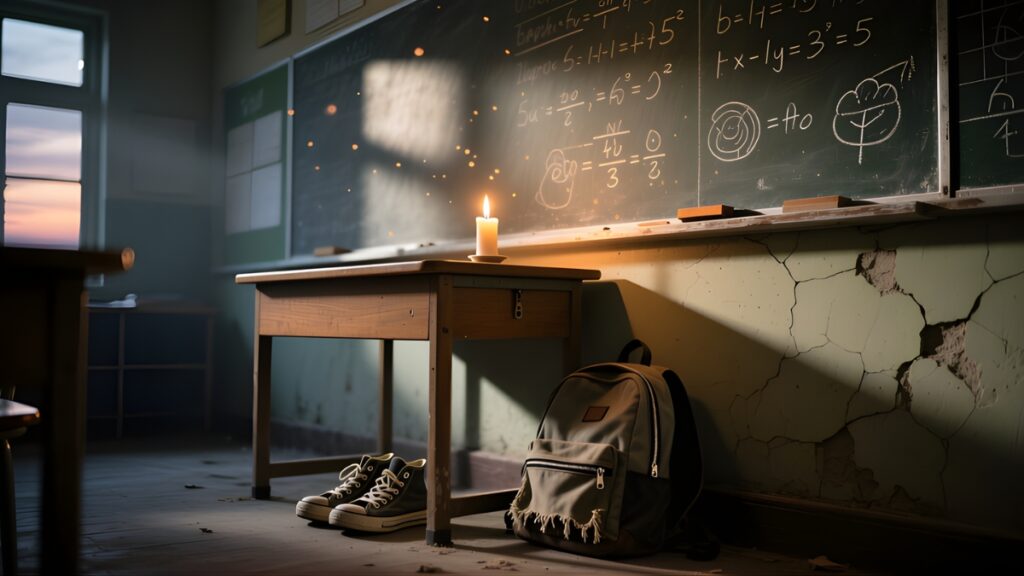
Every school had its mysteries.
At Evergreen Middle School, it was Room 12 — the oldest classroom in the building.
No one used it anymore. The paint peeled, the desks sat dusty and empty, and the old chalkboard was covered with strange, faded writing that no one could erase.
But what made Room 12 famous was the story of the candle.
Students said that sometimes, late in the afternoon, when the hallways grew quiet and the janitor’s cart rattled in the distance, a soft glow would appear in the window.
A single candle, flickering all by itself.
The Dare
It started, as these things usually do, with a dare.
“Bet you won’t go in there,” said Ravi, leaning against his locker.
His friend Emma raised an eyebrow. “Why not?”
“Because Room 12 is haunted,” whispered Noah, pretending to shiver. “Everyone knows that.”
Emma rolled her eyes. “Haunted by who?”
Noah lowered his voice. “By a teacher who loved her students so much, she stayed even after she… well, you know.”
Ravi grinned. “If you’re brave, go see for yourself. After school.”
Emma hesitated. She didn’t believe in ghosts. Not really. But she did love solving a mystery.
“Fine,” she said. “I’ll do it. But if I find anything, you both owe me lunch for a week.”
After School
When the final bell rang, the hallways emptied quickly.
Emma waited until the last group of students had left before slipping toward the end of the hall.
Room 12’s door was half open.
She peeked in.
The air felt cooler there. Dust floated in the sunlight, and the faint smell of chalk and something sweet — like old candles — lingered.
She took a step inside.
“Hello?” she said softly.
Nothing.
She walked to the front of the room, where the teacher’s desk sat beneath the big chalkboard. There was a small brass candle holder sitting right in the middle — with a melted candle stub inside.
Emma frowned. “Okay, that’s weird.”
She touched the desk, and the wood felt warm.
The Whisper
Then she heard it.
A sound — soft, like someone writing with chalk.
Scree… scree… scree…
Emma turned. The chalkboard was empty.
But a single piece of white chalk rolled slowly across the tray and stopped right in the center.
Her heart thumped.
“Okay,” she said nervously, “this is officially creepy.”
Just then, faint letters began to appear across the board — one by one.
Thank you for remembering.
Emma gasped and took a step back. “Who’s there?”
The air shimmered faintly, and for a moment, she thought she saw the shape of a woman — kind eyes, soft gray hair tied back in a bun, and a cardigan that looked like it belonged in another decade.
The figure smiled gently. “Don’t be afraid.”
Emma froze. “You’re… you’re the teacher?”
The woman nodded. “My name is Mrs. Harper. I taught here long ago.”
Mrs. Harper’s Story
Emma swallowed hard but found her voice. “Why are you still here?”
Mrs. Harper’s eyes sparkled like candlelight. “I stayed because this was my favorite place. I loved teaching. My students were my joy.”
She gestured toward the candle on the desk. “Every year, I lit that candle on the last day of school. It was my way of wishing each child a bright future.”
Emma felt a lump in her throat. “That’s… really sweet.”
Mrs. Harper smiled. “But one year, I fell ill before I could say goodbye. The candle never got lit again. So, sometimes, I light it myself — just to remind this room it was once filled with laughter.”
Emma nodded slowly. “That’s why people see the glow.”
Mrs. Harper’s expression softened. “Yes. I never meant to frighten anyone.”
A Small Request
Mrs. Harper looked toward the window. “But soon, they will close this building for good. I don’t want to fade away with it.”
Emma’s eyes widened. “What do you need?”
“Just one thing,” the ghost said quietly. “Light the candle one last time — not for me, but for the children who learned here.”
Emma hesitated only a moment before striking a match from a box on the desk. She lit the small candle.
The flame flickered, warm and gentle.
Mrs. Harper’s face glowed softly in its light. “Thank you, dear.”
The flame danced brighter, filling the room with golden light. The old chalkboard gleamed clean, the desks looked polished again, and for a brief second, Emma heard faint laughter echoing around her — children’s voices, happy and free.
Then, slowly, the ghost faded into the light.
The Next Morning
When Emma told Ravi and Noah what happened, they didn’t believe her.
“No way,” Ravi said. “You’re making that up.”
“Am I?” Emma smiled and opened her backpack. Inside was the brass candle holder, perfectly clean — and beside it, a folded piece of paper.
In neat handwriting it said:
Keep the flame of learning alive.
Mrs. Harper
That week, Emma asked her teacher if she and her friends could clean up Room 12.
They scrubbed the desks, washed the windows, and placed the candle holder right in the center of the room.
On the last day of school, they invited the whole class to light the candle together.
When the tiny flame flickered to life, the sunlight shimmered in the air — just enough that Emma thought she saw Mrs. Harper smiling near the back wall.
Teacher/Parent Notes
Theme: Respect, remembrance, and gratitude for teachers and learning.
Moral: Some lights never fade — especially those lit by kindness and curiosity.
Lesson ideas: Discuss how teachers shape lives, or write a short story about a person whose kindness lives on.
4. The Midnight Post Office
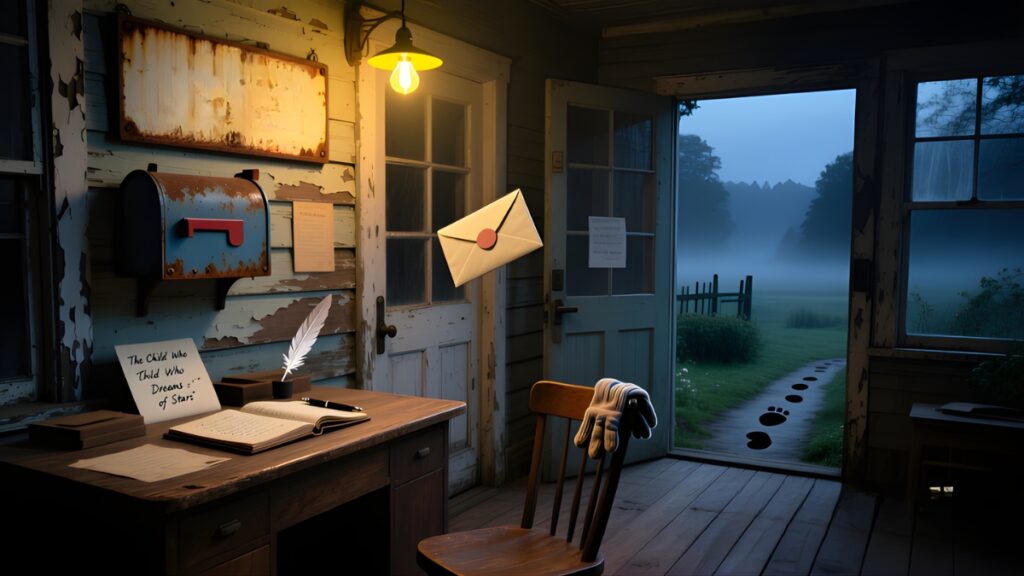
Most kids thought Maple Street Post Office was just an ordinary old building — dusty mail slots, squeaky doors, and a tired clock that was always five minutes slow.
But Lila, age eleven, knew something different.
Every night, as her dad (the night janitor) cleaned the front lobby, she noticed faint lights flickering behind the locked mailroom door.
And once, just once, she thought she heard voices whispering her name.
The Secret Shift
It started on a quiet Tuesday night.
Lila sat behind the front counter, sketching in her notebook while her dad mopped the floor. The air smelled like paper, rain, and lemon cleaner.
Then, right at midnight, the big wall clock clicked.
Its hands both pointed straight up.
And the air changed.
The hum of the lights softened. The shadows stretched longer. A low creak echoed from the mailroom door — the one that was always locked.
Lila’s pencil froze mid-sketch.
Then she saw it: a faint golden glow seeping out from the keyhole.
Through the Door
Her dad had gone upstairs to empty trash bins. Lila’s curiosity bubbled like soda.
She crept closer.
The door, usually stiff, opened easily with a soft sigh.
And there — under the silver light of the moon shining through the window — stood a row of ghostly postal workers.
They wore old uniforms, their badges gleaming faintly. Their hands moved quickly, sorting envelopes that floated gently in the air.
One of them — an elderly man with round glasses and a transparent hat — looked up.
“Oh dear,” he said kindly. “You can see us?”
Lila swallowed. “I… I think so.”
He smiled. “Well then. Welcome to the Midnight Post Office.”
Letters for the Lost
Lila blinked. “What are you doing?”
“Delivering letters that never reached their destination,” the ghostly man said. “We finish the work that time forgot.”
He handed her an envelope. It was pale blue, the edges glowing softly.
“For example,” he continued, “this one was written by a sailor in 1912. It never reached his family. We’ll see it gets there.”
“But…” Lila said, “his family’s probably gone now.”
“Ah,” the man said, smiling. “Sometimes the words still matter. The letter finds where it belongs — not always who.”
Lila looked around. Ghosts floated gently past her, carrying stacks of shimmering envelopes. Some disappeared through walls, others vanished into soft bursts of light.
A Letter With Her Name
Then the old man paused. He turned to the sorting table and frowned.
“Well, that’s unusual,” he said softly.
He picked up an envelope that glowed brighter than the rest. On the front, in delicate handwriting, was written:
“To Lila, from Mom.”
Lila’s breath caught.
Her mother had passed away two years ago.
She reached for the envelope, her fingers trembling.
The old postmaster ghost nodded gently. “Some letters wait for the right moment to be received.”
The Words She Needed
Lila opened it carefully. Inside was her mother’s familiar handwriting.
My dearest Lila,
If you’re reading this, it means you’re brave enough to keep looking for magic in ordinary places. I want you to remember that I’m always proud of you — every drawing, every question, every kind thing you do.
When you miss me, look for small lights in dark places. That’s where love hides.
All my heart, always,
Mom
Tears filled Lila’s eyes. The letter glowed softly in her hands.
“Thank you,” she whispered.
The old ghost smiled. “You humans forget — love doesn’t stop at closed doors or old mailboxes.”
One Last Delivery
“Can I help?” Lila asked suddenly.
The postmaster’s eyebrows lifted. “Help?”
“I can draw. Maybe I can decorate the envelopes. Make them special.”
The ghosts exchanged smiles.
“All right,” said the postmaster. “One night only, you’re officially our honorary postal artist.”
Lila grinned. She found an old pen and began sketching small stars, hearts, and lanterns on the glowing letters. The ghosts floated them away, their faint laughter echoing like wind chimes.
When the last letter was delivered, the postmaster tipped his transparent cap.
“You’ve done fine work, Miss Lila.”
Then the lights began to fade.
Morning Again
Lila woke up at the counter, her head resting on her sketchbook.
The morning sun streamed through the windows. The post office was quiet again.
Had it all been a dream?
She rubbed her eyes — then noticed something in front of her.
A pale blue envelope.
On it was written, in neat handwriting:
“Thank you, Midnight Artist. Keep the lights burning.”
Below the note, in shimmering silver ink, was a small heart — drawn in her own mother’s looping style.
The Secret She Kept
From that day on, Lila looked forward to helping her dad at night.
Sometimes, when the clock struck twelve, she caught a faint golden glow from under the mailroom door — and she smiled.
She never opened it again.
Some magic, she decided, didn’t need to be explained. It just needed to be believed.
Teacher/Parent Notes
Theme: Love beyond loss, imagination, and the unseen kindness that connects people.
Moral: Words — and love — have power that lasts longer than time.
Lesson idea: Encourage children to write “letters of kindness” to someone they appreciate, even if that person is no longer around.
5. Grandma’s Rocking Chair
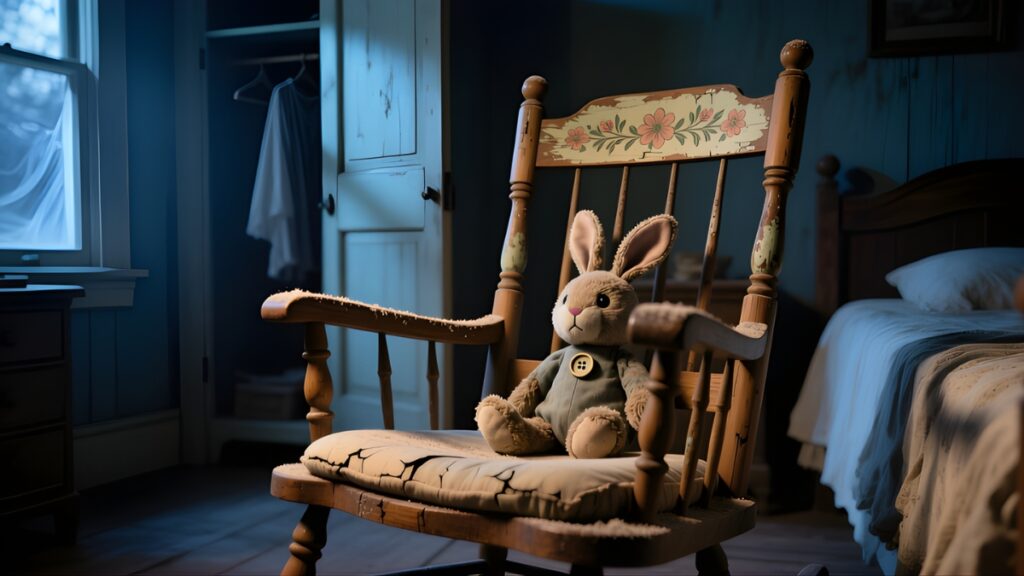
The old rocking chair sat in the corner of the living room, right under the window that looked out over the garden.
It used to be Grandma May’s chair.
Whenever she visited, she’d sit there knitting scarves, humming songs, and telling stories that somehow made the whole house feel softer.
After she passed away, no one sat in that chair anymore.
But sometimes, on quiet evenings, the chair still moved.
Just a little.
Back and forth.
Back and forth.
Moving Day
When Ellie and her family moved into Grandma May’s old house for the summer, she didn’t think much about the rocking chair.
It was dusty, creaky, and covered with a folded quilt that smelled faintly like lavender.
Her mom said, “We’ll clean it tomorrow.”
But that night, Ellie couldn’t sleep.
The wind whispered through the trees outside, and somewhere downstairs, something creaked.
She sat up in bed.
Creaaak… creaaak… creaaak…
It sounded like the rocking chair.
A Midnight Glow
Ellie tiptoed down the stairs, clutching her flashlight. The beam danced across the walls, catching family photos and the shimmer of the old glass cabinet.
When she reached the living room, she froze.
The chair was moving.
Slowly, gently, back and forth — as if someone invisible were sitting there.
Her flashlight flickered, then dimmed completely.
A soft, warm glow filled the room — like candlelight.
And then Ellie smelled it: lavender and sugar cookies, Grandma May’s favorite scent.
“Grandma?” she whispered.
The air shimmered slightly, and Ellie saw her — faint and glowing, sitting in the chair with her gentle smile.
The Message
“Hello, pumpkin,” Grandma said, her voice warm and soft.
Ellie blinked back tears. “But… how are you here?”
Grandma chuckled. “Oh, I come by now and then. This house remembers love, you know. It keeps it in the corners.”
Ellie took a step closer. “I miss you.”
“I know, sweetheart.” Grandma leaned forward, her eyes twinkling. “But I never really left. Every time you laugh, or bake cookies, or help your mom, that’s me too. You carry me with you.”
Ellie sniffled. “But why the chair? Why does it move?”
Grandma smiled. “It rocks when someone needs comfort. It’s the house’s way of saying, ‘You’re not alone.’”
The Secret Quilt
Ellie noticed the quilt draped across Grandma’s lap — the same one that had covered the chair.
It was colorful, with squares of different fabric: blue denim, yellow flannel, red plaid. Each square had tiny stitched initials.
“These were all from your family,” Grandma said, tracing a square gently. “Your mom’s old shirt, your uncle’s baby blanket, even your dad’s work apron. Every piece tells a story.”
Ellie touched one patch near the edge — it had her own name stitched into it.
“But I never made this,” she said.
Grandma smiled. “Not yet. That’s your square to fill when you’re ready. Life adds to the quilt one memory at a time.”
A Promise
“Can I come visit you again?” Ellie asked.
Grandma’s glow dimmed softly. “Maybe not like this, pumpkin. But I’ll always listen. When the chair rocks, it means I’m near.”
Ellie’s eyes filled with tears. “I don’t want you to go.”
Grandma reached out a faint, glowing hand and touched Ellie’s cheek. It felt like sunlight through glass — warm and gentle.
“Love doesn’t leave, Ellie,” she whispered. “It just changes shape.”
And then the glow faded.
The chair stopped moving.
But the scent of lavender lingered.
The Next Morning
When Ellie told her mom what happened, she half expected her to laugh.
Instead, her mom looked thoughtful. “When I was your age,” she said softly, “I saw that chair move, too.”
They both turned toward the corner. The morning sun glowed on the rocking chair, and for a moment, Ellie thought she saw a faint shimmer of light across the quilt.
Her mom smiled. “Maybe Grandma just wanted to remind us she’s still part of this home.”
The Rocking Chair’s Gift
Later that week, Ellie sat in the chair for the first time. It creaked gently under her, like it was saying hello.
She picked up Grandma’s knitting needles from the side table and tried looping some yarn the way she remembered Grandma doing it.
Her fingers fumbled, but she laughed. “I’ll get better,” she said out loud.
The chair creaked once — a small, friendly sound.
And for a second, Ellie could almost hear Grandma humming one of her old tunes.
Teacher/Parent Notes
Theme: Love, family connection, and the comfort of memories.
Moral: The people we love never truly leave us — their warmth lives on in our hearts and traditions.
Discussion idea: Ask children what family traditions or objects remind them of someone they love.
6. The Ghost Painter of Maple Street
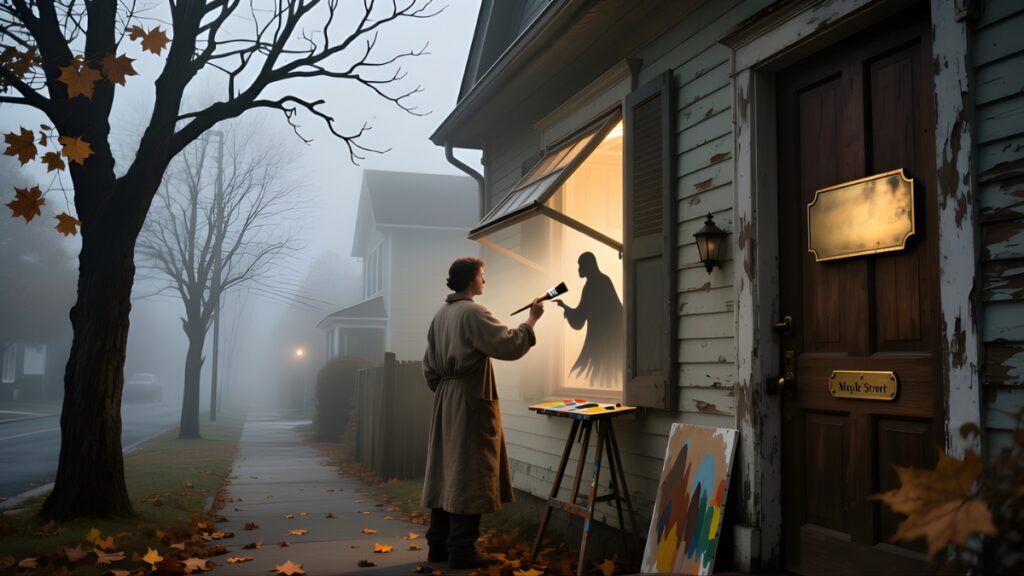
Every morning, the people of Maple Street woke up to something new.
A painting.
Not on paper — but on walls, fences, sidewalks, even the sides of mailboxes.
Each one appeared overnight, as if by magic.
Sunrises made of golden swirls.
Cats with wings.
Children flying kites made of stars.
No one ever saw who made them.
Some said it was a prank. Others whispered it was a ghost.
The Mystery Begins
Leo, age eleven, lived in a small blue house halfway down Maple Street.
He loved art — sketching comic heroes, doodling dragons, and coloring chalk rainbows on the driveway.
So when the first mysterious mural appeared — a giant tree whose branches turned into paintbrushes — Leo was fascinated.
He stared for a long time, tracing each detail with his eyes.
At the bottom corner, tiny initials glimmered faintly in the morning sun:
E.M.
No one in the neighborhood had those initials.
Not anyone living, at least.
The Old House at the End
One afternoon, Leo asked his mom about the initials.
She looked thoughtful. “There used to be a painter named Evelyn Moore who lived at the very end of Maple Street,” she said. “She was famous for her murals — painted half the town before she passed away.”
Leo’s eyes widened. “You mean… Evelyn Moore? Like, the ghost painter?”
His mom laughed. “It’s just an old story. But they say her spirit still wanders around, looking for unfinished walls.”
That night, Leo couldn’t stop thinking about it.
Unfinished walls.
What if she really was still painting?
The Sound of a Brush
At midnight, Leo woke to a strange sound.
Swish… swish… swish.
It wasn’t the wind. It was too steady — like the sound of a paintbrush against a wall.
He crept to the window.
Down the street, a faint silver glow shimmered near the old house at the corner — the one with boarded-up windows and ivy crawling up its sides.
Leo grabbed his sketchbook and flashlight. “If it’s really her,” he whispered, “I have to see.”
The Ghost in the Garden
When he reached the old house, he saw her.
A tall woman in a flowing white shawl, glowing faintly blue, stood before the cracked brick wall.
In her hand was a brush made of light.
Each stroke left trails of glowing color behind — painting a meadow that shimmered with stars.
Leo gasped.
The ghost turned.
Her eyes were kind and soft, like candlelight through glass.
“You can see me,” she said gently.
Leo nodded. “You’re Evelyn Moore, aren’t you?”
The ghost smiled. “What’s left of her, yes. I used to paint this town — every street, every garden. But I never finished this wall.”
“Why not?” Leo asked.
She looked down, her light flickering. “Because I ran out of time.”
The Boy and the Brush
Leo stepped closer. “I can help you finish it.”
Her smile grew brighter. “You paint too?”
He lifted his sketchbook. “All the time.”
Evelyn extended her glowing brush toward him. The moment he touched it, warmth filled his hand — like sunlight mixed with color.
Together, they painted.
The wall came alive with images — swirling clouds, glowing rivers, trees with lanterns in their branches.
The air hummed softly, like a quiet song.
When the last stroke was done, the whole wall glowed golden.
Evelyn looked at Leo, her expression peaceful. “You’ve done what I couldn’t.”
Leo blinked. “But I didn’t finish it alone.”
She smiled faintly. “That’s what art is — never done alone.”
A Gift Left Behind
The glow around Evelyn began to fade.
“Wait!” Leo said. “Will I see you again?”
Her voice drifted like wind through leaves. “Every time you paint something beautiful.”
And then she was gone.
But in Leo’s hand, the brush remained — no longer glowing, just simple wood and bristle.
He turned back to the wall. The painting shimmered faintly in the moonlight, alive and full of warmth.
The Morning Surprise
By sunrise, the whole neighborhood had gathered.
“Another mural!” someone shouted. “It’s breathtaking!”
Leo stood quietly at the edge of the crowd.
Down in the corner, the signature had changed.
It now read: E.M. & L.H.
Evelyn Moore and Leo Harris.
His mom squeezed his shoulder. “Looks like you’ve got a guardian artist watching over you,” she whispered.
Leo smiled. “Maybe she’s watching all of us.”
The Painting That Never Fades
That night, Leo hung the old brush above his desk.
He picked up his pencils and began to draw again — the way Evelyn had shown him.
Outside, the stars seemed a little brighter.
And down on Maple Street, the mural glowed faintly under the moon, never fading, never dulling — as if the ghost painter was still adding touches of light, one stroke at a time.
Teacher/Parent Notes
Theme: Creativity, legacy, and the beauty of continuing someone’s passion.
Moral: Art — and kindness — never really disappear; they keep inspiring new hearts to create.
Discussion idea: Ask kids what kind of art, story, or creation they’d like to be remembered for.
7. The Elevator That Only Went Up at Midnight
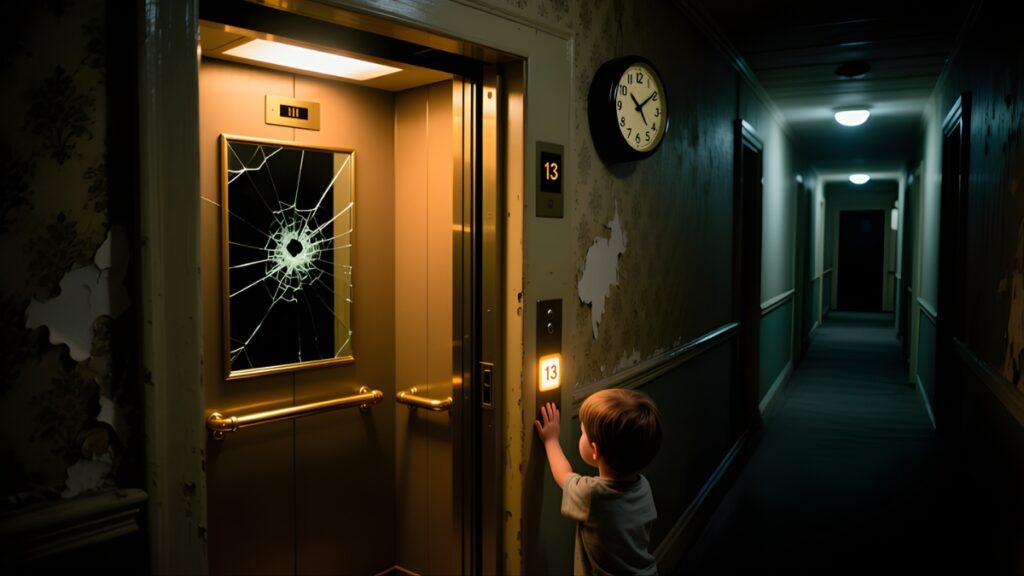
In the heart of Pinewood Apartments stood an old elevator — brass doors, squeaky buttons, and a soft hum that echoed through the halls.
Most days, it worked just fine.
Except for one strange thing.
Every night, exactly at midnight, the elevator would move on its own.
No one pressed a button. No one stepped inside.
Yet it went up.
Always up.
And no one knew where it stopped.
The Midnight Sound
Ten-year-old Maya had lived in Pinewood all her life.
Her room was right next to the elevator shaft, and she’d grown used to its noises — the whirring, the creaking, the soft ding every time someone arrived home.
But one night, just as she was drifting to sleep, she heard something different.
Ding.
Then the sound of the elevator rising — slow, steady, mechanical.
She sat up. “That’s weird,” she whispered.
Everyone in the building was asleep.
The elevator went up, stopped for a second, and then… silence.
The Building’s Old Secret
The next morning, Maya asked her neighbor, Mr. Green, about it. He was the building’s oldest tenant — always feeding pigeons on the balcony or fixing something with his trusty screwdriver.
Mr. Green looked thoughtful. “Ah, the midnight elevator,” he said. “Been doing that for years.”
Maya blinked. “You mean no one knows why?”
He shook his head. “Used to be a rumor. They say the elevator stops at a secret floor. One that doesn’t exist during the day.”
She laughed. “That’s impossible.”
But when she checked the elevator panel later, she noticed something odd.
Between buttons 6 and 7, there was a tiny, faint marking — almost like a rubbed-out number.
She traced it with her finger.
And for a second, the light flickered.
The Plan
That night, Maya decided to stay awake.
If the elevator really went up at midnight, she’d find out where.
She packed a flashlight, her lucky notebook, and a tiny bag of marshmallows (because every good adventure needed snacks).
At 11:59, she crept out of her room and tiptoed into the hallway.
The elevator doors stood quiet and still, reflecting the dim yellow hallway light.
Ding.
The clock struck twelve.
The doors slid open — empty.
Maya took a deep breath. “Here goes nothing.”
She stepped inside.
The Hidden Button
Inside, all the usual buttons glowed softly — 1 through 7.
But as the doors closed, a faint click echoed, and a new button appeared.
It glowed faint silver and read: M
Maya’s heart raced. “M… for midnight?”
She pressed it.
The elevator shuddered and began to rise.
Higher than the seventh floor.
Higher than the roof.
The numbers disappeared.
Outside the small window, everything turned misty and bright.
The Sky Floor
When the doors opened, Maya gasped.
She wasn’t in the building anymore.
The floor was made of glass. Clouds floated below her feet.
Stars shimmered all around, and the air smelled like rain and fresh paint.
In the center of the glowing platform stood a small desk — and behind it, a young boy wearing a blue elevator uniform.
“Welcome,” he said with a smile. “You’re right on time.”
“Where… am I?” Maya whispered.
He handed her a clipboard. “The Sky Floor. Only opens at midnight. We keep track of lost things.”
“Lost things?” she asked.
He pointed to a shelf behind him. It was filled with odd objects — a missing shoe, a torn book page, an old photo, even a teddy bear with one eye.
“All the things people in your building have lost,” he said. “We find them. We keep them safe.”
The Boy from the Past
Maya looked at the boy closely. He seemed about her age — maybe a bit older — but slightly see-through, like the air shimmered around him.
“Wait,” she said slowly. “Are you… a ghost?”
He nodded politely. “Sort of. My name’s Theo. I used to live here — long ago. The elevator broke one night while I was riding it. I never really left.”
Maya’s heart softened. “So you’ve been helping people find what they lost?”
He smiled. “It’s my favorite part of the job. But I think I’ve been waiting for someone who could help me, too.”
The Missing Sketch
Theo handed her a faded drawing — a sketch of a girl feeding pigeons.
“I drew this before the elevator broke,” he said. “I wanted to give it to my sister, but she moved away. I never got to.”
Maya’s eyes widened. “What was her name?”
“Margaret Green,” Theo said softly.
Maya gasped. “Mr. Green! He’s still here — but he’s really old now!”
Theo looked stunned. “You mean… she’s alive?”
Maya nodded. “You can finally send it to her.”
He smiled with watery eyes. “Then you’ve done it — you found my missing piece.”
The Ride Back Down
The lights flickered, and the elevator doors opened again behind Maya.
Theo handed her the sketch. “Please give it to her. When she smiles, I’ll finally rest.”
Maya stepped inside.
“Goodbye, Theo,” she whispered.
“Goodbye, Maya,” he said, fading gently.
The elevator began to descend — softly, smoothly, through clouds and stars — until she landed back on the quiet, carpeted hallway.
When the doors opened, it was 12:01.
The Picture and the Promise
The next morning, Maya ran to Mr. Green’s door.
He opened it slowly, still in his robe. “Maya? What’s got you up so early?”
She handed him the faded sketch.
He froze. His hands trembled as he looked at it. “This… this was my brother’s drawing. Theo.”
Tears filled his eyes.
“He always promised to finish it one day.”
Maya smiled. “He wanted you to have it.”
Mr. Green looked toward the elevator. “Then he finally made it home.”
The Elevator’s Final Ride
That night, Maya stayed up again — waiting.
When the clock struck midnight, she listened closely.
But this time, there was no sound.
No hum. No ding.
The elevator stayed still.
Yet in the faint reflection on its brass doors, Maya thought she saw Theo’s smiling face — waving one last time before fading into starlight.
Parent/Teacher Notes
Theme: Kindness, courage, and closure.
Moral: Sometimes the smallest acts — returning something lost, finishing a promise — can bring peace to others.
Discussion idea: Ask children if they’ve ever lost something important — or done something kind to help someone find what they lost.
At what ages are short ghost stories for kids appropriate?
- Ages 3–5 (Preschool): Avoid true “ghost” scares. Use gentle, whimsical spooky themes (friendly ghosts, silly creaks).
- Ages 6–8 (Early readers): Mild frights are okay. Use clear good-over-bad endings and reassure afterward.
- Ages 9–12 (Tweens): Can handle stronger suspense, twists, and atmosphere. Still avoid graphic or traumatic content.
A simple rule: keep the story short, predictable, and reassuring for younger kids. Scholastic’s advice on telling spooky stories stresses setting the mood and keeping things age-appropriate.
Safety first: How to tell spooky stories without causing harm
- Preview every story before you read it aloud. Know the tone and ending.
- Use a “safe zone” — tell stories in a bright room or a familiar place so kids don’t feel trapped. Scholastic recommends flashlights or slightly dimmed lights depending on age.
- De-brief afterwards. Ask: “What would you do if that happened?” and “How could we keep safe?” This builds coping skills. Child Mind Institute guidance on managing fears can help caregivers respond calmly and teach kids coping strategies.
- Avoid ambiguous, unresolved endings for younger listeners; ambiguity can fuel anxiety.
- Use humor as a safety valve. Laughing at the “monster” at the end makes fear manageable.
Storytelling tips that make short ghost stories for kids work
- Pace your voice. Slow starts build mood; quick finishes release tension.
- Use sensory detail sparingly. A single eerie sound (“the attic clock ticked backward”) is more effective than long descriptions.
- Give the child agency. Stories where kids solve the mystery or use bravery empower listeners.
- Ask predictive questions. “What do you think is behind the door?” invites participation and reduces helplessness.
- End with routine. Follow a spooky story with a comforting ritual—turn on a soft lamp, share a warm drink, sing a lullaby.
ReadWriteThink has classroom lessons showing how scary stories can motivate learning when handled thoughtfully.
What is a good short ghost story for kids?
A good short ghost story for kids is age-appropriate, brief (2–8 minutes to read), focuses on curiosity rather than gore, ends with reassurance, and invites kids to ask questions and solve the mystery with the storyteller.
How to adapt these short ghost stories for different ages
- For preschoolers: simplify language, add sound effects, and finish with a comforting routine.
- For early readers: ask prediction questions and let a child read a repeated line.
- For tweens: expand atmosphere, add a small twist of mystery, and invite them to write their own ending.
Classroom uses: literacy, critical thinking, and creativity
Short ghost stories for kids are ideal mini-units for school:
- Story structure lessons: identify beginning, middle, end.
- Vocabulary practice: pick 5 spooky (but safe) words to teach.
- Creative writing: students write a sequel or explain the “mystery.”
- Emotional check-ins: discuss how characters handled fear.
ReadWriteThink lesson plans show how scary stories can teach narrative structure while staying classroom-safe.
Common FAQs
Are ghost stories bad for kids?
Not if chosen carefully. Short ghost stories for kids that emphasize problem-solving and end with safety can help children practice managing fear.
How late is too late for ghost stories?
Avoid spooky tales right before sleep for very young or sensitive children. Share them earlier in the evening, and follow with ca
How do I know if a child is too sensitive?
Watch behavior after the story—trouble sleeping, repeated questions about the same fear, or increased clinginess may signal sensitivity. Respond with reassurance and lighter stories.
Final checklist for telling short ghost stories for kids
- Preview the story yourself.
- Choose the right story for the child’s age.
- Keep it short and end on reassurance.
- Use voice, pauses, and small props—light a flashlight for fun.
- Debrief with questions and a calming routine.
Conclusion
Short ghost stories for kids can be magical tools for imagination, language development, and emotional growth when used thoughtfully. Choose age-appropriate tales, prepare a reassuring end, and use the story as a chance to teach problem-solving and coping skills.
Whether you read a two-minute lantern tale or a slightly longer mystery, the right short ghost stories for kids will create warm memories—spooky, safe, and unforgettable. Try one tonight, and notice how curiosity and comfort can go hand in hand.
Call to action: Want a downloadable packet of five read-aloud short ghost stories for different ages (preschool, early reader, and tween)? Reply “Packet please” and I’ll prepare them tailored to your child’s age.

